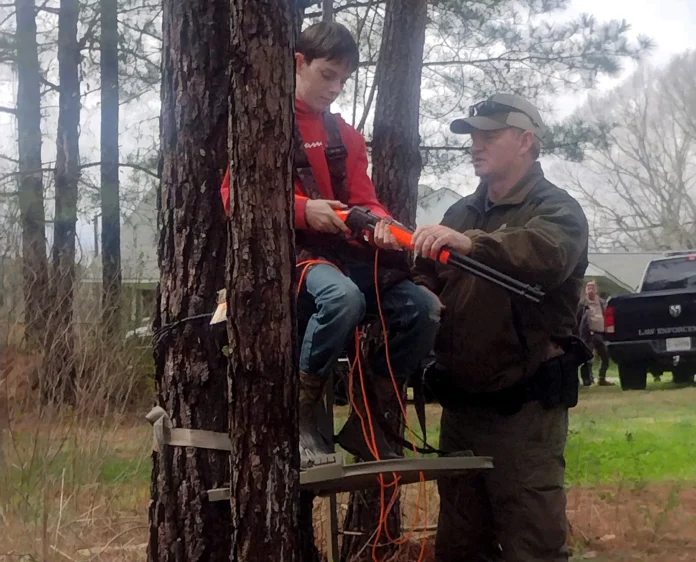
MONTGOMERY, Ala. – Alabama hunters are apparently more aware of the safety aspects of climbing a tree during hunting season. During the 2023-2024 season, only six treestand accidents were reported, down significantly from the average.
Unfortunately, Alabama’s two years without a hunting fatality ended with two this past season.
Michael Bloxom, hunter education coordinator with the Alabama Department of Conservation and Natural Resources (ADCNR) Wildlife and Freshwater Fisheries (WFF) Division, said the first fatality occurred during a duck hunting trip in January. The teenage victim pulled his shotgun out of the back seat of the truck with the muzzle pointing toward him when the shotgun discharged.
“That is a classic example of a common accident,” Bloxom said. “Always have the muzzle pointed in a safe direction whether it’s traveling, hunting, target shooting or whatever. And if you’re traveling, it’s better to keep the firearms unloaded and cased.”
The second fatality occurred during a feral swine hunting trip at night in March when another teenage victim was shot by one of his hunting partners.
“They had shot a hog during a legal nighttime hunt,” Bloxom said. “The rifle was slung on the shooter’s shoulder, and they were walking to go get the hog. Apparently, the victim was walking behind. Somehow, that rifle slung around on the hunter’s arm, pointed backwards and went off, striking the victim.
“One thing to point out with semi-automatic rifles or shotguns: Sometimes you think they’re unloaded when actually another round has been cycled into the chamber. The best practice is to remove the magazine and cycle the action to make sure the chamber is clear.”
Four other firearms-related accidents were nonfatal. One hunter was using a pull-up rope with the muzzle of the gun pointed up when it discharged. Two duck hunting accidents and one dove hunting accident occurred when hunters shot at low-flying birds.
The total of six treestand accidents is far lower than last year’s 15 treestand accidents.
“Typically, two-thirds of all hunting accidents are treestand accidents,” Bloxom said. “We actually may be making some headway on getting people to wear their fall-arrest systems. That includes your safety harness and your safety line attached to the tree.”
Bloxom said the incorrect assumption is that many treestand accidents occur using climbing treestands.
“Of our accidents this past season, three were hang-on stands and three were ladder stands,” he said. “Most people think climbers are more dangerous. I went back at our records and looked. In general, it’s the hang-on and ladder stands. People can leave the hang-ons up for years and years. They really need to be taken down and inspected every season. I had one accident, and the hunter couldn’t understand why it failed, but the stand had been up so long that the tree had actually grown around the chain securing the stand.
“The ladder-stand accidents tend to be because of improper installation. They’ve really got to hook that center strap or support bar in tight. Most of the instructions call for three people to install them. If you don’t put that ladder stand up correctly, it can be a problem.”
Although individuals who need to complete a hunter education course before purchasing a hunting license have a variety of options to complete the course, Bloxom still thinks the in-person classes provide the most benefits. Visit www.outdooralabama.com/hunting/HunterEd for information and classes available. Anyone born on or after August 1, 1977, is required to complete an approved hunter education course. The hunter education courses are available for those 10 years and older.
“The online courses meet the IHEA-USA certification requirements and do a great job with consistent delivery and messages for those who prefer online learning,” Bloxom said. “However, for those who feel they need a bit more hands-on training, we’re promoting our in-person classes. At the in-person classes they can interact with the instructors and ask questions. In our traditional classes, we try to find locations where we can have shotgun shooting or rifle shooting. In places where we can’t do live fire, we have some nice pellet rifles with scopes that we use to teach shooting skills and safety skills. We have the orange Mossberg training guns that are non-firing that students can use and get hands-on experience.
“And the students have a chance to put on a safety harness. Some people claim it’s too hard to put on, it takes too much time and it’s uncomfortable. But we teach them they can have a safety harness on in a minute or less and possibly save their lives. I also urge the kids to bring their dads and granddads, because they, unfortunately, need the safety reminders.”
WFF Hunter Education urges hunters to follow the 11 guidelines for using a treestand safely:
- Always wear a safety harness, also known as a fall-arrest system, when you are in a treestand, as well as when climbing into or out of a treestand. Statistics show that the majority of treestand incidents occur while climbing in and out of a stand.
- A safety strap should be attached to the tree to prevent you from falling more than 12 inches.
- Always inspect the safety harness for signs of wear or damage before each use.
- Follow all manufacturers’ instructions for use of a safety harness and stand.
- Follow the three-point rule of treestand safety. Always have three points of contact to the steps or ladder before moving. This could be two arms and one leg holding and stepping on the ladder or one arm and two legs in contact with the ladder before moving. Be cautious that rain, frost, ice or snow can cause steps to become extremely slippery. Check the security of the step before placing your weight on it.
- Always hunt with a plan and, if possible, a buddy. Before you leave home, let others know your exact hunting location, when you plan to return and who is with you.
- Always carry emergency signal devices such as a cell phone, walkie-talkie, whistle, signal flare, PLD (personal locator device) and flashlight at all times and within reach even while you are suspended in your fall-arrest system. Watch for changing weather conditions. In the event of an incident, remain calm and seek help immediately.
- Always select the proper tree for use with your treestand. Select a live, straight tree that fits within the size limits recommended in your treestand’s instructions. Do not climb or place a treestand against a leaning tree.
- Never leave a treestand installed for more than two weeks since damage could result from changing weather conditions and/or from other factors not obvious with a visual inspection.
- Always use a haul line to pull up your gear and unloaded firearm or bow to your treestand once you have reached your desired hunting height. Never climb with anything in your hands or on your back. Prior to descending, lower your equipment on the opposite side of the tree.
- Always know your physical limitations. Don’t take chances. Do not climb when impaired by drugs, alcohol or if you’re sick or fatigued. If you start thinking about how high you are, stop climbing.
Bloxom also reminds hunters to review and follow the 10 commandments of firearms safety:
- Treat every firearm as if it is loaded.
- Control the muzzle of your firearm. Keep the barrel pointed in a safe direction. Never point a firearm at anything that you do not wish to shoot and insist that your shooting and hunting companions do the same.
- Be sure of your target and beyond. Positively identify your target before you fire, and make sure no people, livestock, roads or buildings are beyond the target.
- Never shoot at water or a hard, flat surface. A ricocheting bullet cannot be controlled.
- Don’t use a scope for target identification; use binoculars.
- Never climb a tree, cross a fence or jump a ditch with a loaded firearm.
- Store guns and ammunition separately. Store firearms under lock and key and use a gun case to transport firearms.
- Make sure your barrel and action are clear of all obstructions.
- Unload firearms when not in use. Never take someone else’s word that a firearm is unloaded. Check yourself.
- Avoid drugs and alcohol when hunting or shooting. Even some over-the-counter medicines can cause impairment.
For those interested in firearms instruction, WFF’s Hunter Education Unit hosts multiple one-day courses teaching firearm safety and marksmanship. Go to www.outdooralabama.com/outdoor-alabama-academy/firearms-101-introduction-handguns-and-shotguns and search for a course near you that provides assistance from certified firearms instructors.


















